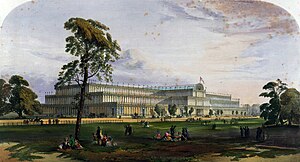
Imperial College London (Imperial) is a public research university in London, England. Its history began with Prince Albert, consort of Queen Victoria, who envisioned a cultural area including the Royal Albert Hall, the Victoria and Albert Museum, the Natural History Museum and in addition to several royal colleges. Established by royal charter in 1907, Imperial unified into one institution the Royal College of Science, the Royal School of Mines and the City and Guilds of London Institute. In 1988, the Imperial College School of Medicine was formed for undergraduates as part of the college's Faculty of Medicine by merging with St Mary's Hospital Medical School. In 2004, Queen Elizabeth II opened the Imperial College Business School.

The Crystal Palace was a cast iron and plate glass structure, originally built in Hyde Park, London, to house the Great Exhibition of 1851. The exhibition took place from 1 May to 15 October 1851, and more than 14,000 exhibitors from around the world gathered in its 990,000-square-foot (92,000 m2) exhibition space to display examples of technology developed in the Industrial Revolution. Designed by Joseph Paxton, the Great Exhibition building was 1,851 feet (564 m) long, with an interior height of 128 feet (39 m), and was three times the size of St Paul's Cathedral.
The Royal College of Science is a higher education institution located in South Kensington; it is a constituent college of Imperial College London from 1907 until it was wholly absorbed by Imperial in 2002. Still to this day, graduates from the Faculty of Natural Sciences at Imperial College London receive an Associateship to the Royal College of Science. Organisations linked with the college include the Royal College of Science Union and the Royal College of Science Association.

The Great Exhibition of the Works of Industry of All Nations, also known as the Great Exhibition or the Crystal Palace Exhibition, was an international exhibition that took place in Hyde Park, London, from 1 May to 15 October 1851. It was the first in a series of World's Fairs, exhibitions of culture and industry that became popular in the 19th century. The event was organised by Henry Cole and Prince Albert, husband of Victoria, Queen of the United Kingdom.

The International Exhibition of 1862, officially the London International Exhibition of Industry and Art, also known as the Great London Exposition, was a world's fair held from 1 May to 1 November 1862 in South Kensington, London, England. The site now houses museums including the Natural History Museum and the Science Museum.

The City and Guilds of London Institute is an educational organisation in the United Kingdom. Founded on 11 November 1878 by the City of London and 16 livery companies to develop a national system of technical education, the institute has been operating under royal charter, granted by Queen Victoria, since 1900. The Prince of Wales, later King Edward VII, was appointed the first president of the institute.

Albertopolis is the nickname given to the area centred on Exhibition Road in London, named after Prince Albert, consort of Queen Victoria. It contains many educational and cultural sites. It lies in the former village of Brompton in Middlesex, renamed as South Kensington, split between the Royal Borough of Kensington and Chelsea and the City of Westminster, and the area bordered by Cromwell Road to the south and Kensington Road to the north.

Benjamin Waterhouse Hawkins was an English sculptor and natural history artist renowned for his work on the life-size models of dinosaurs in the Crystal Palace Park in south London. The models, accurately made using the latest scientific knowledge, created a sensation at the time. Hawkins was also a noted lecturer on zoological topics.

Sir Henry Cole FRSA was a British civil servant and inventor who facilitated many innovations in commerce and education in the 19th century in the United Kingdom. Cole is credited with devising the concept of sending greetings cards at Christmas time, introducing the world's first commercial Christmas card in 1843.

Sir Matthew Digby Wyatt was a British architect and art historian who became Secretary of the Great Exhibition, Surveyor of the East India Company and the first Slade Professor of Fine Art at the University of Cambridge. From 1855 until 1859 he was honorary secretary of the Royal Institute of British Architects, and in 1866 received the Royal Gold Medal.

Exhibition Road is a street in South Kensington, London which is home to several major museums and academic establishments, including the Victoria and Albert Museum, the Science Museum and the Natural History Museum.

The Queen's Lawn is a green lawned area situated at the centre of Imperial College London's South Kensington campus, next to the Queen's Tower and immediately to the north of Imperial College Road. It provides an open space of 1,600 sq metres, and is surrounded by the Abdus Salam Library, and the Sherfield administration, Chemistry, and Skempton buildings. It is often the site of college events, including student bands, fairs, and balls, as well as student activism.
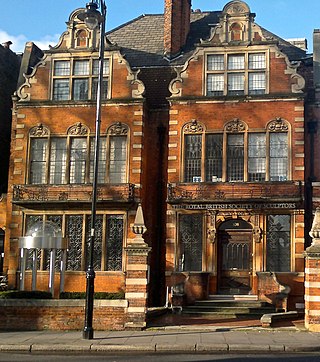
The Royal Society of Sculptors (RSS) is a British charity established in 1905, which promotes excellence in the art and practice of sculpture. Its headquarters are a centre for contemporary sculpture on Old Brompton Road in South Kensington, London. It is the oldest and largest organisation dedicated to sculpture in the UK. Until 2017, it was known as the Royal British Society of Sculptors.
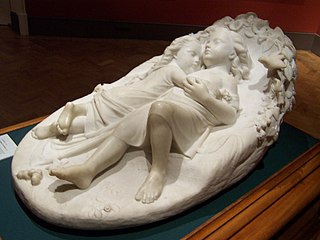
John Bell (1812–1895) was a British sculptor, born in Bell's Row, Great Yarmouth, Norfolk. His family home was Hopton Hall, Suffolk. His works were shown at the Great Exhibition of 1851, and he was responsible for the marble group representing "America" on the Albert Memorial in London.
An exempt charity is an institution established in England and Wales for charitable purposes which is exempt from registration with, and oversight by, the Charity Commission for England and Wales.
Francis Whishaw was an English civil engineer. He was known for his role in the Society of Arts, and as a writer on railways. Later in life he was a promoter of telegraph companies.
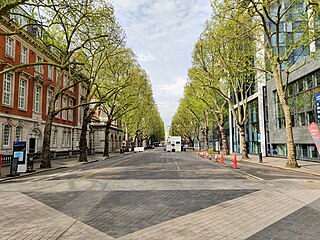
Imperial College Road is a tree-lined road in South Kensington, London, England. It runs east–west with Queen's Gate to the west and Exhibition Road to the east.
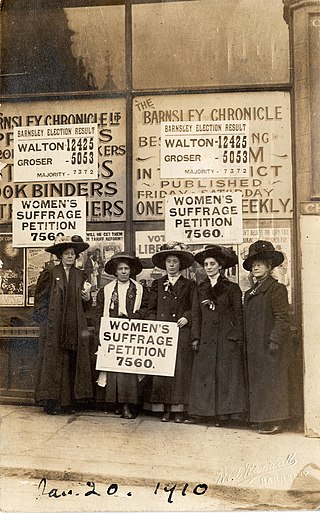
Alice Laura Embleton was one of the first women to study sciences at the University College of South Wales and Monmouthshire, and among the first group of women to be appointed Fellows of the Linnean Society in 1905. A biologist and zoologist, Embleton developed work on pesticides to improve crop production. She was also a noted suffragist.
Carole Robb (1943) is a British artist and member of the National Academy of Design in New York City. She lives between New York City, Rome, Venice, and London.
